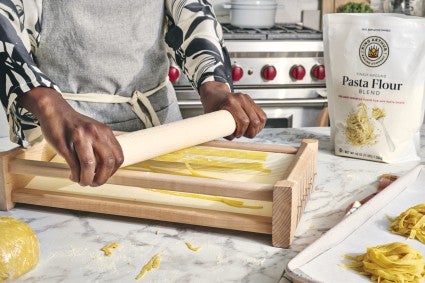A pasta tool to bring out your inner Italian granny
Why your kitchen needs a chitarra.


There are a lot of options for cutting pasta dough, from the multi-purpose Atlas 150 to the electric Pasta Fresca to a plain old chef's knife. But my new favorite method is actually a centuries-old tool: the Chitarra Pasta Cutter.
A chitarra (pronunced key-tahr-rah) is a pasta cutting tool that hails from Abruzzo, in the central region of Italy. It features stainless steel wires tautly strung across a wooden frame and resembles a stringed instrument (chitarra means guitar in Italian). To use a chitarra, rolled-out fresh pasta sheets are pushed through the wires using a rolling pin, cutting the dough into long ribbons of pasta. The noodles fall below onto a slanted wooden board, where they can be twirled into nests to rest before cooking or dried on a rack for later use.
One advantage to this unique cutting technique is that it creates pasta with textured edges. The stainless steel strings leave the edges square and gives the strands texture, rather than round (like traditional spaghetti that’s extruded from a die cut), so sauces cling easily. Traditionally, spaghetti alla chitarra (sometimes called maccheroni alla chitarra) is paired with meat-based ragù sauces, though anything else like pesto or plain red sauce will work well too. This pasta cutter is also reversible: One side has strings further apart to make 5 millimeter-thick spaghetti, and on the other side, you can make 3 millimeter-thick tagliatelle.

The chitarra may not be the quickest way to cut pasta (for that, I recommend this Pasta Fresca machine), but it offers something else: a tactile way to engage in the long tradition of Italian cooking. It’s a tool that’s centuries old (with some records dating back to the Middle Ages!), and despite technological advancements, this pasta cutter hasn’t changed much from when it was invented. It’s retained its nostalgic charm, and there’s a reason it’s still made and used to this day.
If you’re looking to slow down and make the most of your pasta-making experience (perhaps with a glass of wine and a cooking companion to enjoy the process with), cooking with the chitarra is well worth the effort.


Cover photo and food styling by Liz Neily.

